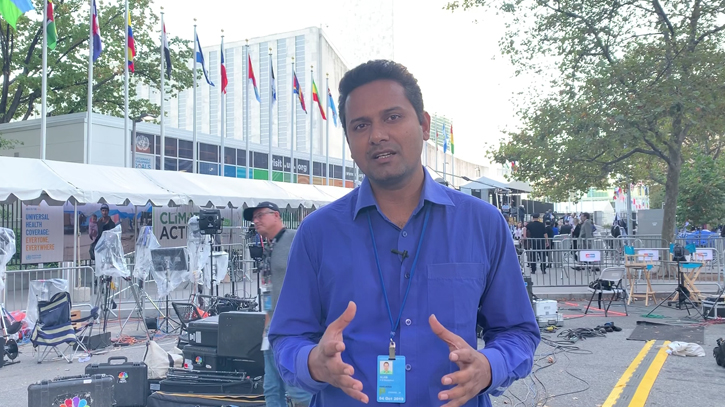
G M Mostafizul Alam, a special correspondent for Channel 24. Photo: Collected
G M Mostafizul Alam, a special correspondent for Channel 24, is renowned for his investigative reports on climate change and environmental issues. His extensive coverage includes major climatic events like cyclones, floods, and landslides in Bangladesh. Notably, he received the 'Investigative Journalism Awards 2015' from Transparency International Bangladesh for his work in climate finance governance. He has also reported from international platforms such as the UN Climate Change Conference.
In an interview with the Daily Messenger, G M Mostafizul Alam discusses the catastrophic impact of salinity intrusion in the South-Western region of Bangladesh, addressing its causes, consequences, future climate change impacts, and potential solutions.
Messenger: You've extensively covered the escalating salinity issue and its repercussions in the southwestern region of Bangladesh. How dire is the situation presently?
G M Mostafizul Alam: The coastal upazilas of the southwestern region face severe scarcity of food and potable water. In these areas, nearly all underground and surface water sources are saline.
To illustrate, let's consider Mongla upazila. With a population of approximately 150,000, it comprises 35,939 households. Shockingly, 61% of these households lack access to safe drinking water. Excluding municipalities, the figure rises to 67%, meaning 18,314 households in Mongla upazila lack safe drinking water.
Only 6.6% of the population in Mongla upazila have access to tap or pipeline water, while 4.4% rely on tube wells. The remaining 88.9% must fetch drinking water from distant sources such as rainwater, ponds, or rivers, with distances ranging from half a kilometer to 8 kilometers.
Pipeline water supply is limited to the Mongla Municipal area. Consequently, during the dry season, many residents are forced to purchase water for consumption at prices exceeding 1 taka per liter. In contrast, residents of Dhaka city receive 65 liters of water for 1 taka. The scarcity of clean water exposes the population to various waterborne diseases.
Also, the expansion of saline land is alarming, increasing from 833,450 hectares in 1973 to 1,056,260 hectares in 2009, a 26% rise in 35 years, primarily in the southwestern region. Salinity levels in rivers have also surged, for instance, from 2 ppt in 1962 to 20 ppt in 2008 at Mangla Point in the Pasur River. Thus, the crisis in food security and the environment in the Southwest region is undeniable.
Messenger: How has the population trend evolved in response to the challenges faced in the southwestern region?
G M Mostafizul Alam: Census data from 2011 reveals negative population growth rates in various districts: -0.17 in Jhalakathi, -0.13 in Barisal, -0.25 in Khulna, 0.62 in Satkhira, and -0.47 in Bagerhat. Between 2002 and 2021, Khulna city experienced a negative annual average population growth of -1.38%, according to worldpopulationreview.com.
This decline in birth rates suggests not heightened awareness, education, or better living standards but rather the inability of people to sustain themselves. Increased frequency and intensity of cyclones and storm surge due to climate change disrupt livelihoods and compel people to leave their homes.
Messenger: Regarding the impact of climate change in Bangladesh, there's often mention of increasing salinity in the southwestern region. What's your perspective on the accuracy of this claim?
G M Mostafizul Alam: Climate change, while playing a role, isn't the primary culprit behind the rising salinity. In my view, it's largely man-made. When India initiated water withdrawals during the dry season post the construction of the Farakka Barrage on the Ganges River, salinity levels spiked, particularly in the south-western region.
This trend peaked between 1990 and 1996. During the dry season, the absence of water flow from the Ganges into the Gorai River led to saltwater intrusion, with ocean tides penetrating as far as 70 km upstream, significantly elevating salinity levels across vast areas.
Messenger: Considering the current situation, if we factor in the impact of climate change, what do you foresee?
G M Mostafizul Alam: Climate change is poised to exacerbate the frequency and intensity of storm surges. The coastal region of Bangladesh, particularly the southwestern areas, will bear the brunt of these extreme disasters.
Over recent decades, rising global temperatures have led to a continuous increase in sea levels, driven by the melting ice in polar regions. In 2021, the global mean sea level reached a record high, rising at an average rate of 4.5 millimeters per year from 2013 to 2021, compared to 2.1 millimeters per year during 1993-2002.
Currently, the global average temperature is more than 1.1°C above the pre-industrial average of 1850–1900. However, existing policies suggest a potential 3°C temperature rise by the century's end.
Messenger: What initiatives do you believe are necessary to address this crisis?
G M Mostafizul Alam: Addressing climate change impacts necessitates comprehensive planning and robust execution. With the expected increase in frequency and intensity of cyclones and storm surges, strengthening early warning systems is essential to mitigate damage.
To safeguard the lives, livelihoods, environment, and communities of the southwestern region, it's imperative to secure a fair share of Ganges water. Renewing the Ganges Water Treaty, expiring in 2026, is crucial. Vigorous diplomatic efforts are needed to ensure the renewal of this agreement with India, avoiding a situation akin to the unresolved Teesta Treaty.
Messenger/Disha








